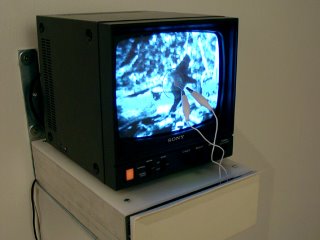Encryptozoology

The infamous 1967 Patterson-Gimlin film which depicts the Bigfoot tromping through a Californian forest, has recieved acres of scrutiny over the years. Breaking down the footage into frame-by-frame analysis, skeptics and believers alike debate the nature of the creature's gait. The work of Eadward Muybridge comes to mind, as these motion studies arrest and interrogate the illusion of animation-if only in an attempt to see the illusionary animal for what it 'really' is! The interrogation of moving images in these Bigfoot afficionados' sites seems secondary- the main issue is concerning the discovery (or not) of dubious content.
Contemporary artist Kevin H. Jones has explored this footage using sensors that appear to track the activity of light/dark values on a screen that is displaying the Patterson-Gimlin sequence (see picture above). Jones inverts the subject of inquiry in this media spectacle. He inspects the medium---he looks into, rather than at the image, now electronic, a single point of light flitting speedily across the screen. The "anima" in question is not that of the potential man in a monkey suit, but the flucuation of information patterns. But this is terminal information... It is a loop, both technically and culturally. It has replayed to the point of recognition at the expense of its own exhaustion. Overload equals pattern recognition, and the Patterson-Gimlin film is overloaded, the Bigfoot-as-Image is overexposed. The Patterson-Gimlin Bigfoot, the Bigfoot-as-Image is no longer "a difference that makes a difference" (Bateson), it has been discovered, exploited for commercial gain. It has been domesticated.
That the Bigfoot has most often eluded encounters, left nothing but fleeting traces, retained a certain autonomous status, manoevered in stealth-suggests that this creature is not so easily ensnared in traditional representational modes. Might the Bigfeet, (and cryptids generally) seek encryption of a sort less aligned with images proper as they come to inhabit and lurk in the augmented environments of information space?

0 Comments:
Post a Comment
<< Home